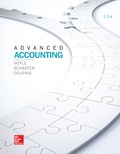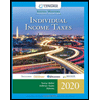
Concept explainers
Identify the correct option for the amount of cash that person B will receive before any of the other partners collect any cash.
Answer to Problem 9P
Option c. The amount of cash that person B will receive before any of the other partners collect any cash is $17,000.
Explanation of Solution
Calculate the amount of cash available:
Calculate the maximum allocated loss to each partner:
Now, find for all the other partners:
Now, find for partner B:
Now, find for partner J:
Person M shares a minimum amount of loss and is in the most feasible condition with 30% share and maximum allocated loss of $130,000.
Calculate the distribution of loss of $130,000 to all the partners
Now, loss to other partners
Loss distribution to all the partners
| Particulars | Person K | Person M | Person B | Person J |
| Beginning balance | $ 59,000 | $ 39,000 | $ 34,000 | $ 34,000 |
| Loss | $ (52,000) | $ (39,000) | $ (13,000) | $ (26,000) |
| Ending balance | $ 7,000 | $ - | $ 21,000 | $ 8,000 |
Table: (1)
Calculate maximum allocated loss to other three partners
Now, find for partner B
Now, find for partner J
Person K shares a minimum amount of loss and is in the most feasible condition with 40% share and maximum allocated loss of $12,250.
Calculate the distribution of loss of $12,250 to all the partners
Now, loss to other partners
Loss distribution to all the partners
| Particulars | Person K | Person B | Person J |
| Beginning balance | $ 7,000 | $ 21,000 | $ 8,000 |
| Loss | $ (7,000) | $ (1,750) | $ (3,500) |
| Ending balance | $ - | $ 19,250 | $ 4,500 |
Table: (2)
Calculate maximum allocated loss to other two partners
Now, find for partner J
Person J shares a minimum amount of loss and is in the most feasible condition with 20% share and maximum allocated loss of $6,750.
Calculate the distribution of loss of $6,750 to all the partners
Loss distribution to all the partners
| Particulars | Person B | Person J |
| Beginning balance | $ 19,250 | $ 4,500 |
| Loss | $ (2,250) | $ (4,500) |
| Ending balance | $ 17,000 | $ - |
Table: (3)
a.
$12,250 is the incorrect option because this is not the amount of cash that person B will receive before any of the other partners collect any cash.
b.
$14,750 is the incorrect option because this is not the amount of cash that person B will receive before any of the other partners collect any cash.
c.
$17,000 is the correct option because this is the amount of cash that person B will receive before any of the other partners collect any cash.
d.
$19,500 is the incorrect option because this is not the amount of cash that person B will receive before any of the other partners collect any cash.
Want to see more full solutions like this?
Chapter 15 Solutions
Soft Bound Version for Advanced Accounting 13th Edition
- Riverstone Publishers Inc. collects 80% of its sales on account in the month of the sale and 20% in the month following the sale. If sales on account are budgeted to be $450,000 for June and $380,000 for July, what are the budgeted cash receipts from sales on account for July?arrow_forwardNeed help this questionarrow_forwardSubject: financial accountingarrow_forward
- Hudson Textiles computes its predetermined overhead rate annually on the basis of direct labor hours. At the beginning of the year, it was estimated that 18,000 direct labor hours would be required for the period's estimated level of production. The company also estimated $88,000 of fixed manufacturing overhead expenses for the coming period and variable manufacturing overhead of $3 per direct labor hour. Hudson's actual manufacturing overhead for the year was $140,600 and its actual total direct labor was 19,000 hours. Compute the company's predetermined overhead rate for the year.arrow_forwardPlease help me solve this financial accounting problemarrow_forwardCan you help me solve this general accounting problem with the correct methodology?arrow_forward
- How much is Natasha's contribution margin ratio?arrow_forwardHello tutor please given General accounting question answer do fast and properly explain all answerarrow_forwardSuppose the required reserve ratio is 0.20 and individuals hold no cash. Total bank deposits are $150 million, and the banks hold $40 million in reserves. How much more money can the bank create if it does not hold excess reserves? Want Answerarrow_forward
- Principles of Accounting Volume 1AccountingISBN:9781947172685Author:OpenStaxPublisher:OpenStax College
 Individual Income TaxesAccountingISBN:9780357109731Author:HoffmanPublisher:CENGAGE LEARNING - CONSIGNMENT
Individual Income TaxesAccountingISBN:9780357109731Author:HoffmanPublisher:CENGAGE LEARNING - CONSIGNMENT





